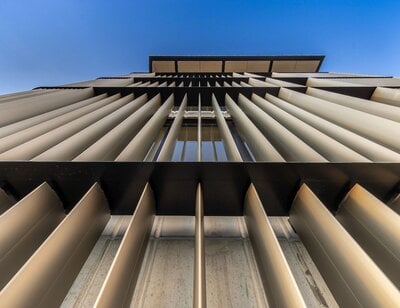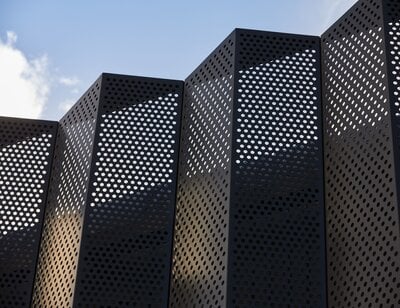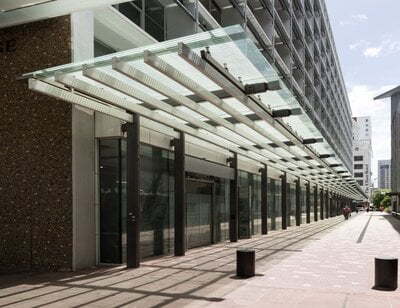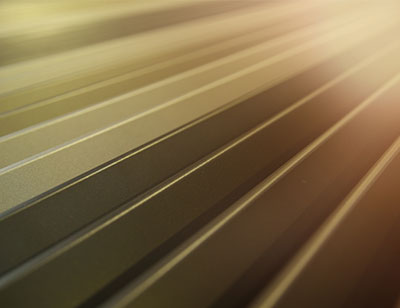The terms canopy and verandah are generally used interchangeably when describing a covered walkway attached to a building. Yet neither really mean 'covered walkway'. At least, not in relation to the etymological origin of the words. Canopy was originally 'kanopeion', a Greek word used to describe an Egyptian couch with mosquito curtains. Verandah is thought to be from Hindi or the Portuguese varanda. Both were used to describe long balcony or terrace. So whilst we'll use the term canopy, in some publications (such as the Invercargill City District Plan) verandah is used. In both cases, they mean 'covered walkway' (or covered entrance) and have nothing to do with either mosquito curtains or long balconies. Now that's cleared up - what are they are why do we need them?
Different Types of Canopies
The easiest way to categorise canopies is by purpose. Vehicle canopies provide cover for vehicle movements and are typified by use in loading bays and industrial premises, where the loading and unloading of goods requires some degree of shelter from the elements. In hospitality settings, they provide cover for guests to arrive and move from vehicle to building without the elements ruining their entrance, or their luggage.
Pedestrian canopies make it more pleasant for people to transit from place to place, comfortably shielded from the sun, rain, or both. They make inner city streets more appealing, encourage foot traffic and add to the hustle, bustle and vibrancy of cities. So really they do the same thing as vehicle canopies. You just can't get a vehicle under them...unless you're very determined.
Vehicle Canopies
Space Between Buildings
Pretty much as it sounds. The canopy connects buildings, using the space between them. At least one 'end' is open and most commonly, both ends are open, allowing for vehicle movements in and out of the space. That space is generally used for loading and unloading, or for vehicles to park up. Even in New Zealand, they might require shelter from the sun sometimes.
Cantilever Canopy
Secured to the side of a building without the need for canopy posts, these are typically found in the loading bay of industrial premises, commercial building entrances or at fast-food drive through windows. They tend to cover a smaller space and are used for more modest requirements compared to canopies between buildings.
Pedestrian Canopies
The cantilever canopies referenced above are also suitable as pedestrian canopies, one of a range of options for pedestrians which include:
Entranceway Canopy
Exactly as it sounds (there's no confusing etymology here). An entranceway canopy is attached to the building above a doorway, protruding outwards to provide some degree of protection from the elements. Basically, they are there for those moments when you exit the building to be confronted by driving rain. You use them to shelter for a few seconds when deciding whether to make a run for it or not, before invariably deciding to, only be completely soaked within 10 metres of wherever your finish line is. Ok, it's not for that. But it does happen.
Canopy Supported by Building & Posts
These generally tend to be larger examples of entranceway canopies, thus requiring the use of posts to support a more substantial canopy projection. Whilst not exclusively the domain of grander buildings (read: bigger buildings) they are frequently found where the entranceway to a building has a pedestrian area out front with stairs leading to the entrance, or an area with seating or for people to gather undercover.
Walkway Canopy (freestanding)
Those vital arterial walking routes found around hospitals, universities and in the CBD. They all benefit from a walkway canopy for the safe transit of pedestrians and visitors. The need is probably more acute in the inner City than anywhere else. The relentless march of digital shopping, out of town retail precincts and the on-going behavioural changes from Covid, have all left many High Streets in need of every possible trick to welcome the general public and keep them there.
Canopies Between Buildings
In a perfect world you can move from one building to another with a related purpose, all without getting wet or bowled over by the wind. Think of a McDonalds next to the Bar. Or even a McDonalds next to the gym. Maybe from the train station or bus terminal to the shopping centre anyway.
Canopy Construction Options
Any of the above canopies may be constructed from various materials, the choice of which really depends on what you want the canopy to do. And, no doubt, what budget is available.
Solid Canopies
These really can be anything. Well, anything solid that is typically used in construction anyway. So that's steel, aluminium, wood, stone etc, sometimes built up with carpentry material and waterproofing overtop. For durability and affordability, aluminium canopies are arguably the most attractive option. There's little need for maintenance and no issues of corrosion and general wear to worry about.
Canvas Canopies
Traditionally made from cotton, which has some performance limitations outdoors, modern canvas canopies are constructed from synthetic materials designed for greater longevity. These might be vinyl coated polyesters, acrylic coated polyester or a modacrylic, which is fibre made from acrylonitrile. The reason for the variations and choices is largely due to the need to overcome issues associated with UV degradation, mildew and a tendency for some canvas canopies to become discoloured and stained.
Louvred Canopy
Finally, sometimes all that's needed might be a little shading to protect pedestrians from the harshness of the sun. Particularly in sunny places like Invercargill and Edinburgh. A louvred canopy can do this and is visually attractive, as is perforated aluminium, with the added benefit of visual attraction from the dappled light underneath.
The materials used for any of the above can vary. We obviously work with aluminium rather than steel where possible. The reasons being it's cheaper, lighter and generally more manageable. It often requires less maintenance and offers a level of corrosion resistance few materials can match. Aluminium will retain its lustre for longer and we feel this ability to retain the original aesthetics really sets it apart. From a more functional viewpoint, most steel canopies will have exposed downspouts. These can cause long term damage and result in the need for early replacements and/or repairs. Aluminium canopies can drain internally.
The canopies we manufacture aren't purely aluminium. The majority will incorporate material such as PET (Polyethylene terephthalate - a clear, strong and lightweight plastic) or glass. Then there is lighting. Where a canopy provides shade during the day, there is often a need for illumination at night time, with some degree of integrated lighting.
The Benefits of Canopies
These can be broken down into two categories; visual and physical. The visual benefits speak to the need to beautify, whilst the physical benefits deal with the need to provide protection from wind, rain and the sun.
Visual Benefits
In the words of Frank Lloyd Wright; 'all fine architectural values are human values, else not valuable'. Canopies can be used to create the human scale for the building to be relatable to the human dimension. Creating a sense of natural order helps individuals interact with the environment.
They can also add to the overall design of a building. The blending of the visual with the functional to create an impression is an architectural skill that always impresses. We're fortunate enough to be involved in some wonderful projects and there is much to be admired about designs which seem to effortlessly work for both artistic and occupant functionality reasons.
For entrance canopies there is another benefit. They guide the eye. They say 'come over here - this where you get in'. Obviously retail businesses will benefit from this but so does pretty much any business. Even lawyers. The 'welcome' of an entrance canopy shows a sense of caring and makes people feel appreciated. It might be a subconscious psychological benefit but it's there all the same.
The curb appeal and wow factor of a canopy can be used as a beacon for attention. Especially when competing against an urban environment full of attention grabbing devices and messages. Indeed, a City itself is a form of visual language, communicating a cacophony of messages from children asking for help finding a lost cat, to conspiracy theorists arguing 5G will sour milk at 100 yards.
Which brings us to another benefit of a canopy. It's a canvas to brand and be used for advertising. Or maybe a nice subtle identification of the business inside anyway.
Physical Benefits
The most obvious benefit is protection from the weather. A canopy offers respite from the wind and rain. Or the sun and dangerous UV rays. More than that, they offer pedestrians the chance to slow down. In the inner city, they provide an opportunity to take a breath and pause in the fight against the elements. This is especially important for retail operations nearby as there is a direct link between dwell time and propensity to purchase. This is why many shops will play more relaxed music with a slower BPM. It keeps shoppers inside their stores for longer and that'll lead to higher sales. Conversely, duty free stores at airports will often play more uptempo music as they aim to quickly dispense people through the tills before the next plane load arrives.
There's also something in the ability to decompress before entering a building. That moment, when protected against the elements, you can close the umbrella and give it a shake. Or lower the hood and unzip the coat from up around your chin. A physical action that helps you prepare mentally to step foot inside.
In many CBDs a continuous is needed, allowing for the safe transit of pedestrians from one part of the CBD to another, from one building to another. Equally important are the spaces along this routeway where pedestrians may gather. If only to sit at a bench and rest a moment. Or whilst they wait for a bus, taxi or Uber.
Finally, when big enough a canopy can be used to extend the business to the outdoors. A place for drinkers at a bar to spill out on the street or patrons at a restaurant to take their favourite meal outdoors.
Simply put, canopies are useful. There's no deny their ability to transition people from place to place, or from the inside to the outside. Visually appealing and functionally excellent, they play an important but generally unacknowledged role in the built environment. At least, unacknowledged by most passers-by. However, every now and then someone will hopefully stop and turn to the person they're with and say; 'did you know canopies were originally designed to keep Egyptians safe from mosquitoes as they relaxed on their sofas'.
For more information on canopies and both our standard range of off-the-shelf options and details on bespoke canopy design, please contact us here.








